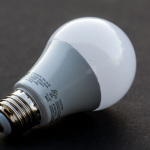Did you know that LED lights can grow plants in greenhouses? LED lights are becoming more and more popular for various reasons, including their energy efficiency and long lifespan. LED lights emit a type of light that is beneficial for plant growth. It is because LED lights emit a specific wavelength of light that helps to promote photosynthesis. Photosynthesis is the process that plants use to convert light into energy. So, by using LED lights in a greenhouse, you can help your plants grow more efficiently. LED lights can also help to extend the growing season for greenhouse crops. Using LED lights inside a greenhouse can create a warm, welcoming environment for your plants, even when it is cold outside. It can help you get a jump on the growing season and produce earlier harvests.
Read more: Low Carbon Economy Challenge
LEDs are more energy-efficient than high-pressure sodium lights in greenhouses. Researchers are also investigating how they can increase the quality of fruits, vegetables, flowers, and marijuana.
How is Lightning Significant in Greenhouses?
Lighting is one of the most expensive aspects of running a greenhouse. Extra illumination benefits greenhouse operators in Ontario and warmer, sunnier regions south of the border. Greenhouse operators have traditionally relied on high-pressure sodium (HPS) illumination, but LEDs are gaining favor. Why? They’re far more energy-efficient, with significant potential for lowering overall energy consumption and operating expenses.
What do Studies Suggest?
According to the Greenhouse Energy Profile Study1 issued by the Independent Electricity System Operator in September 2019, LED grow lights can consume 35 to 55 percent less energy than HPS lamps. Growers can be even more confident that these lights will function effectively for them as performance standards for horticulture LEDs improve. LEDs can give growers more control over how light affects the quality of their crops, be more energy-efficient, and have a longer lifespan than previous alternatives. LEDs can be dimmed and set up and shut down faster than HPS lights. They can also provide different light spectrum (or color) combinations and more focused light.
Because every plant is distinct, the benefits of LEDs might manifest themselves in different ways depending on what a greenhouse is growing — fruits, vegetables, flowers, or cannabis. “Growers must decide what they want to achieve with illumination – is its better quality, shorter production cycles, or control of plant habits?” says James Dyck, an Ontario Ministry of Agriculture, Food and Rural Affairs researcher. LEDs are being tested and studied by researchers all around North America. Here are a few encouraging results to consider as you determine how to employ LEDs in your greenhouse.
Benefits of Using Led Lights in Greenhouses as Shown by Research
- LEDs may result in fuller flowers: Researchers from the University of Guelph experimented to see how spectrum light affected decorative flowers such as marigolds and geraniums. They discovered that pure blue light was more effective than red light in inducing blooming. It turns out that the flower species studied have a “memory” for blue light throughout their early stages of development.
According to Mike Dixon, an environmental systems researcher and professor at the University of Guelph, “LEDs can affect plant flowering, growth (height and width), the flavor of the fruits or plants, and nutritional or medicinal value.” “Each plant response can be manipulated using different light spectra and environment control recipes.”
The researchers also discovered that blue light encouraged plant stems to expand, implying that plants are lacking in light and must “reach” for it. They recommend that growers use blue light throughout the early stages of development before moving to red light.
- When it comes to fruits and vegetables, the correct light recipe is crucial: To learn more about the influence of LEDs on tomatoes and peppers, researchers from Canada’s Department of Agriculture and Agri-Food conducted experiments. The scientists conducted a 24-hour continuous lighting experiment on tomatoes, alternating between red and blue light. They discovered that this increased fruit output in the early stages of production. It also enhanced the height and area of the plant’s leaves. They discovered that a hybrid technique (40 percent HPS and 60 percent purple LED) with white LED resulted in greater fruit yields in winter and summer in peppers. Certain leafy plants may benefit from LED lighting as well. According to one study, exposing lettuce to 50% blue light for an hour at the end of the day raised fresh weights (the weight at harvest) by 18%. Fresh weight was increased by over 11% using a red-blue light combo. Cannabis farmers may be able to increase cannabis leaf expansion using the same ways. Some of which have antimicrobial characteristics, and spectral light may enhance secondary metabolites. As a result, LEDs may aid in the improvement of plant therapeutic characteristics and the deterrence of certain pests. LEDs, for example, were found to increase anthocyanins, which have antioxidant properties, in baby lettuce.
- Higher light can equal more yield — and more cash – for cannabis: There is a “1% rule” in cannabis production in an LED lighting firm: when illumination intensity increases by 1%, flower weight gain – or yield – increases by 1%. According to Lumigrow, growers may be able to employ the light spectrum to generate higher-quality cannabis plants. According to some research, increasing blue light by 13 to 20% reduces plant height by 10%, allowing farmers to create cannabis with robust root growth, compact structure, and thicker leaves. LEDs may boost total active cannabinoids per acre and potentially improve cannabis plant productivity and quality (compared to HPS lighting). More active cannabinoids, which include the therapeutic elements in cannabis, may increase farmer profitability.
Whatever you’re cultivating, LEDs are worth investigating more. See how Save on Energy incentives can assist greenhouse operators in upgrading to these energy-efficient lights.








Leave a Reply